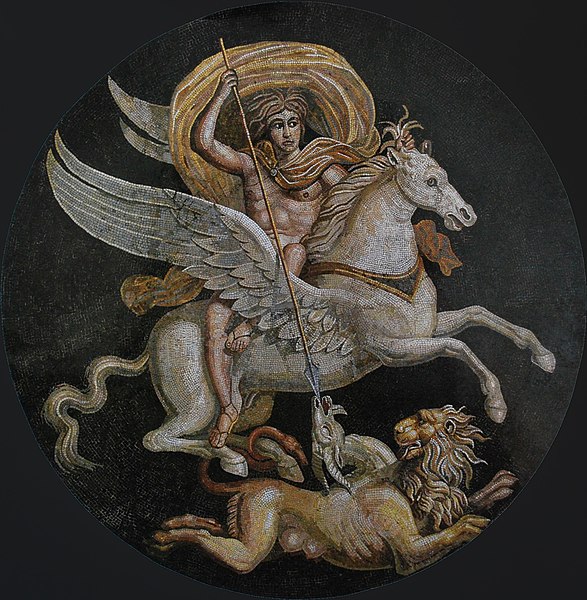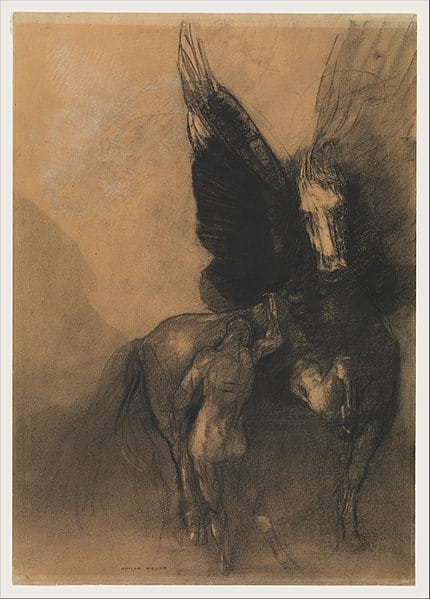In the vast expanse of Greek mythology, Pegasus, the magnificent winged horse, holds a special place. Born from the blood of Medusa, Snake-Haired Monster and tamed by heroes, his tales are as enchanting as his flights across the heavens.
Pegasus Key Facts
| Origin | Born from Medusa’s blood |
| Creator | None |
| Tamed by | Bellerophon |
| Habitat | Mount Helicon & Olympus |
| Other names | None |
| Roman name | Pegasus |
| Associated with | Muses, Springs of Inspiration |
| Symbols | Wings, Springs |
Name and Etymology
The name “Pegasus” is derived from the Greek word “pegai,” which means “springs” or “waters.” This etymology is fitting, given his association with the springs of inspiration on Mount Helicon. In Roman mythology, he retains the same name, emphasizing his universal appeal and significance. Over time, Pegasus has become synonymous with poetic inspiration, and his name evokes images of majestic flights and divine creativity.
In Roman tales, Pegasus remains a symbol of inspiration and majesty. His name, unchanged in translation, stands as a testament to his enduring legacy across cultures.

Pegasus’ Origin and Creation
Pegasus’ birth is as dramatic as his tales. He sprang forth from the blood of the Gorgon Medusa when she was slain by the hero Perseus, The Legendary Slayer of Medusa. This unique origin, born not from union but from a moment of violence, sets Pegasus apart from other creatures in Greek mythology.
His association with the divine is evident from his early days. After his birth, Pegasus made his way to Mount Helicon, home to the Muses, The Divine Inspirations Behind Art, Science, and Culture. Here, he struck the ground with his hoof, giving rise to the Hippocrene, the spring of the Muses, further cementing his role as a symbol of poetic inspiration.
Throughout his existence, Pegasus remained a creature of purity and inspiration. His flights across the skies and his associations with heroes and deities alike make his tales both enchanting and emblematic of the wonders of Greek mythology.
Depiction And Characteristics
Pegasus, with his majestic wings and graceful form, is a symbol of freedom, inspiration, and divine favor.
Pegasus is often depicted as a pure white horse with grand, feathered wings that enable him to soar through the skies. His form, both powerful and elegant, embodies the essence of freedom and majesty. In many artistic renditions, Pegasus is shown either in flight, symbolizing inspiration, or by the side of a spring, emphasizing his role in birthing the springs of the Muses.
Pegasus’ Nature and Behavior
Pegasus, unlike many creatures of Greek mythology, is not characterized by wildness or malevolence. Instead, he is often portrayed as gentle, noble, and somewhat elusive. His association with the Muses and his role in creating the springs of inspiration paint a picture of a creature deeply connected to the arts and divine creativity.
Pegasus’ Abilities
Foremost among them is his power of flight. With his grand, feathered wings, Pegasus could soar through the skies, transcending earthly bounds and reaching divine realms. This ability to fly made him an invaluable ally to heroes like Bellerophon, especially in battles against formidable foes like the Chimera.
Another unique ability attributed to Pegasus is his association with springs. With a mere touch of his hoof, Pegasus could birth springs, the most famous being the Hippocrene on Mount Helicon. This spring, known as the “Spring of the Muses,” was believed to inspire poetic and artistic creativity in those who drank from it. This act of birthing the Hippocrene further solidified Pegasus’ role as a muse and symbol of divine inspiration.
Comparison to another mythical horse
When comparing Pegasus to Sleipnir, Odin’s eight-legged steed from Norse mythology, some intriguing parallels and contrasts emerge. While Pegasus is celebrated for his flight, Sleipnir is famed for his unmatched speed and ability to traverse between realms. That is including both the world of the living and the land of the dead. Both steeds serve divine figures; Pegasus served Zeus by carrying his thunderbolts, while Sleipnir was the trusted mount of Odin, the Allfather in Norse myths. However, their origins differ significantly. While Pegasus was born from the blood of Medusa, Sleipnir was born to Loki, the trickster god, in a rather complex tale of transformation and deception. Despite these differences, both Pegasus and Sleipnir hold esteemed positions in their respective mythologies, symbolizing divine favor, power, and transcendence.
Myths about Pegasus
Pegasus, the winged steed, is central to several captivating tales in Greek mythology, each highlighting his divine nature, his bond with heroes, and his role in inspiring the arts.
Pegasus and Bellerophon
The tale of Pegasus and Bellerophon is one of adventure and camaraderie. Bellerophon, a hero of Greek mythology, sought to tame the wild winged horse. With a golden bridle gifted by the goddess Athena, the goddess of wisdom, he succeeded in his quest, forming an unbreakable bond with Pegasus.
Together, they embarked on numerous adventures, the most notable being their battle against the Chimera. This monstrous creature, with the body of a lion, the tail of a serpent, and the head of a goat, was laying waste to the lands. Riding Pegasus, Bellerophon confronted and defeated the Chimera, showcasing the unparalleled might of a hero when paired with a divine steed. Their adventures didn’t end there; they also faced challenges like the Amazons and the Solymi, but their bond and combined strength saw them through each trial.
Pegasus and the Muses
After his adventures with Bellerophon, Pegasus found solace on Mount Helicon, the abode of the Muses. These nine goddesses of the arts and sciences welcomed the winged horse, recognizing his divine nature and the inspiration he brought with him. It was here that he, with a strike of his hoof, birthed the Hippocrene, a spring that would later be known as the “Spring of the Muses.”
This act wasn’t just a display of his divine power. Moreover, it was also symbolic of his role in inspiring poets, musicians, and artists. The Muses, enchanted by the spring, claimed it as their own, and it’s said that those who drank from the Hippocrene were blessed with poetic inspiration and artistic prowess. Pegasus’ association with the Muses solidified his role as a symbol of artistic inspiration in Greek mythology.
Pegasus’ Journey to Mount Olympus
Pegasus’ feats on Earth, from aiding heroes to inspiring the arts, caught the attention of Zeus, the king of the gods. Recognizing the winged horse’s divine nature and potential, Zeus invited him to Mount Olympus, the heavenly abode of the gods. Here, he was given the honor of carrying Zeus’ thunderbolts, a task of great importance and responsibility.
This transition from Earth to Olympus wasn’t just a physical journey for Pegasus but also a symbolic one. From being born out of violence when Medusa was slain, to aiding heroes, and finally serving Zeus. Pegasus’ journey is a testament to his enduring legacy and divine nature in Greek mythology.

Representations Of Pegasus In Art
Pegasus, with his ethereal beauty, has been a favorite subject in art across ages. Ancient pottery often showcases him in flight or by the side of heroes like Bellerophon. The Renaissance period, with its emphasis on classical themes, saw a resurgence in depictions of him, often symbolizing divine inspiration or the lofty pursuits of the arts.
Mentions in Ancient Texts
Pegasus, with his majestic flights and divine associations, has captured the imaginations of many ancient writers, each offering their unique perspective on this winged steed’s tales and significance.
Hesiod, one of the earliest Greek poets, provides a detailed account of Pegasus’ birth in his work “Theogony,” written around 700 BC. According to Hesiod, he sprang forth from the blood of Medusa after she was beheaded by Perseus. This origin, both violent and miraculous, sets the stage for Pegasus’ subsequent adventures and his ascent to the divine realms. Hesiod’s portrayal emphasizes his unique birth and his immediate association with the divine. This is setting him apart from many other creatures in Greek myths.
Another significant mention is in Homer’s “Iliad.” Pegasus is not a central figure in this epic tale of the Trojan War. However, his adventures with the hero Bellerophon are recounted with admiration and reverence. Homer’s rendition, penned around the 8th century BC, captures the bond between the hero and the winged horse. Moreover, detailing their combined might, and their triumphs against formidable foes like the Chimera. A memorable line from the “Iliad” encapsulates their bond: “With Pegasus beneath him, Bellerophon became a force unmatched, soaring to victories divine.”
Ovid, in his “Metamorphoses,” offers a Roman perspective on Pegasus’ tales. Emphasizing his role in birthing the Muses’ spring and his eventual place among the stars as a constellation. Pindar, the lyrical poet, also sings praises of Pegasus in his odes. He is often associating the winged steed with poetic inspiration and divine favor.
Frequently Asked Questions
Bellerophon, with Athena’s aid, tamed Pegasus and rode him into several adventures, including the battle against the Chimera.
Pegasus sprang forth from the blood of the Gorgon Medusa when she was slain by the hero Perseus.
Pegasus sired two children, Celeris and Melanippe, both of whom inherited their father’s ability to fly.
After his adventures, Pegasus made Mount Olympus his home, serving Zeus and becoming a symbol of divine inspiration.
Yes, Pegasus is immortalized as a constellation in the northern sky, further emphasizing his divine nature and legacy.
Featured Image Credit: Sergey Sosnovskiy, Public domain, via Wikimedia Commons
